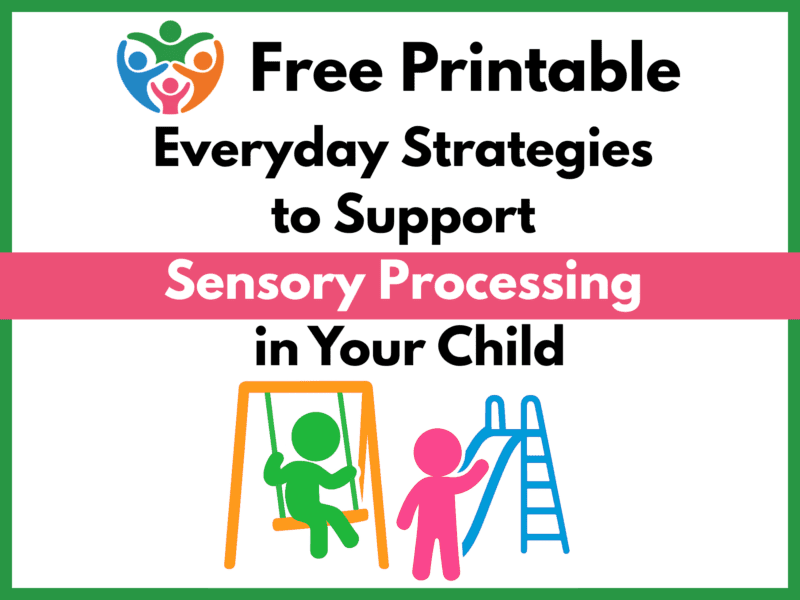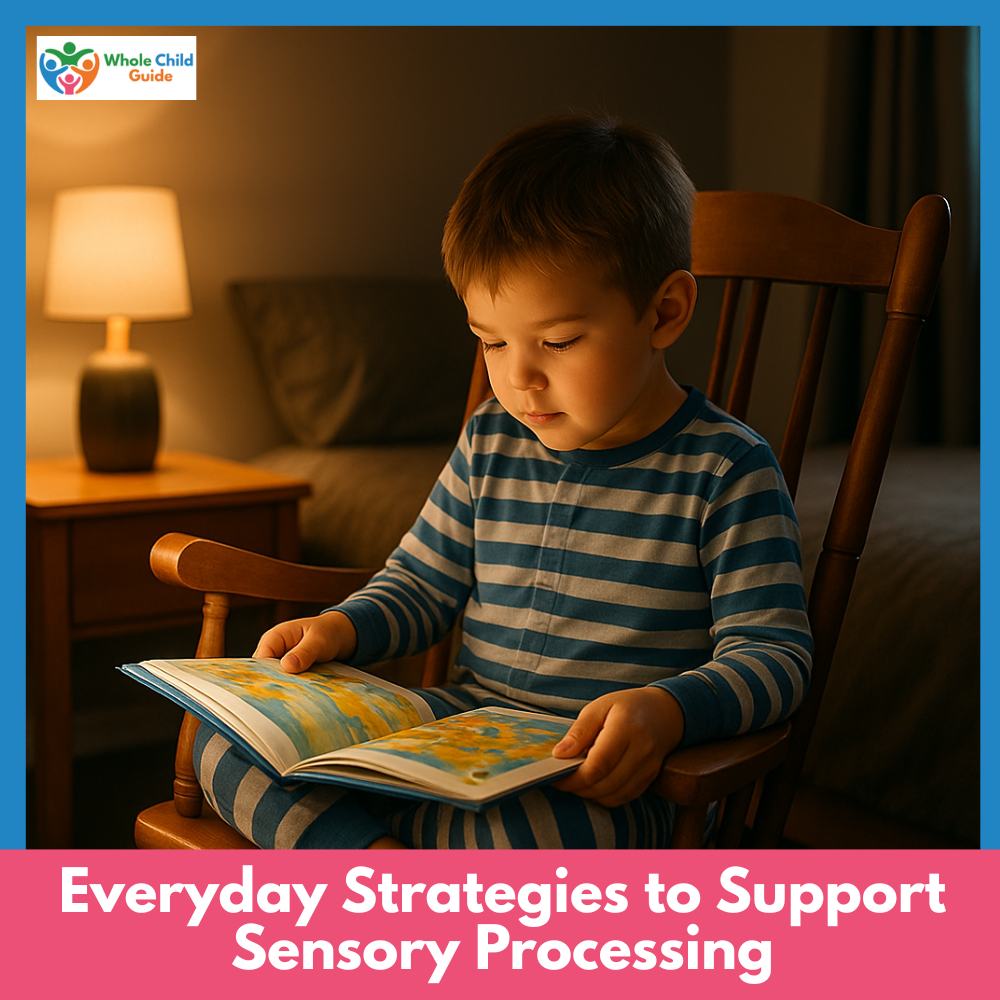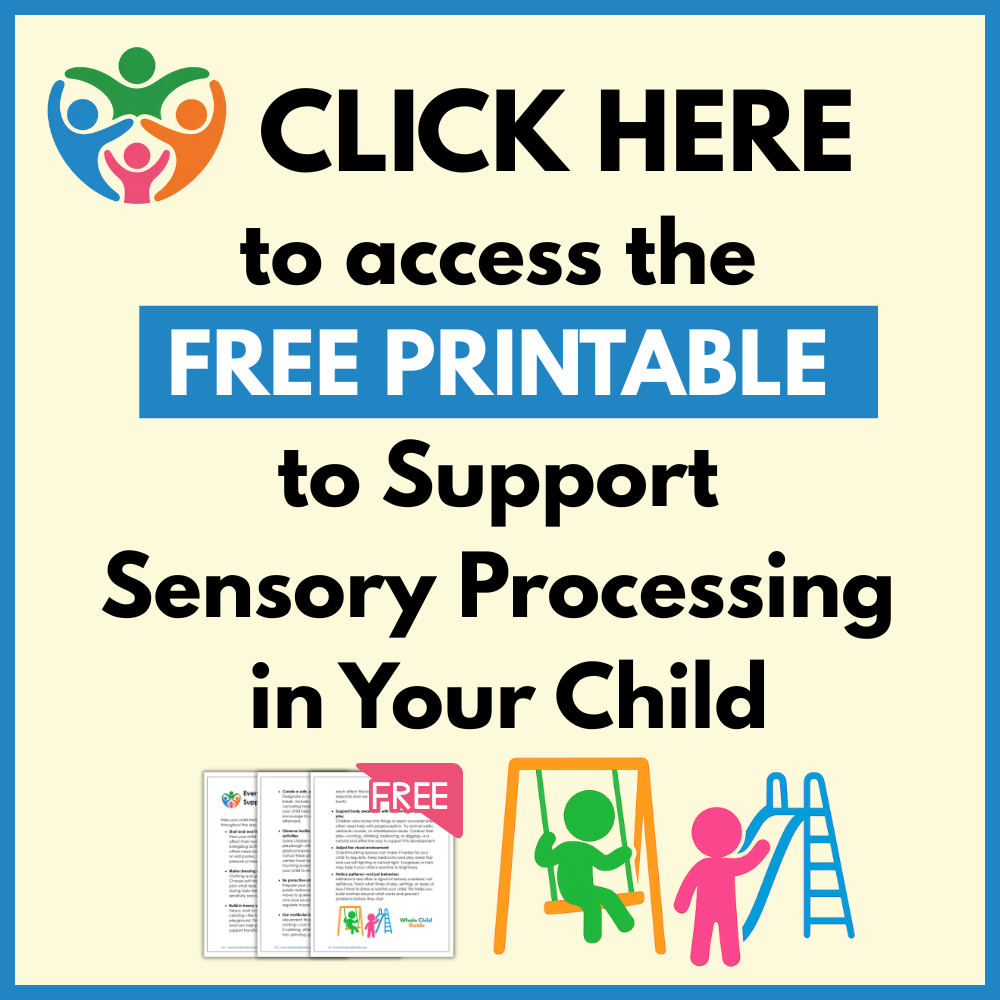
In this blog post, we’re coving simple, daily strategies to help your child feel more regulated, focused, and calm. Grab the free printable PDF below for the full list of sensory processing strategies for parents.
Sensory processing is how the nervous system receives messages from the senses and turns them into appropriate motor and behavioral responses. For many children, this process runs smoothly. But for others, it can feel like the volume is turned too high (or too low), making it harder to stay regulated and focused during everyday tasks.
This post is part of our series on Parenting Support, guiding you through easy, real-life routines that nurture your child’s development across ten key areas of development. Today’s focus: sensory processing.
Why Sensory Processing Matters
Sensory processing impacts how your child interacts with the world, and that’s everything throughout the day. If a sensory challenge is present, you may see issues with sleep, meals (textures and preferred foods), dressing and hygiene, social interactions, interacting in the community, and every setting that the child is involved in, from noisy classrooms to movement on the playground. When a child’s sensory needs are unmet or misunderstood, it can show up as “behavior,” avoidance, meltdowns, or difficulty with focus and participation.
By integrating small, sensory-supportive moments into your daily routine, you can help your child feel more grounded, confident, and ready to learn and play.
The Behavior-Sensory Connection
If you’ve already read our blog post on everyday strategies to support behavior and emotional regulation, you know that behavior is often a response to sensory input. When we meet our kids’ sensory needs proactively, especially through consistent, supportive routines, we reduce overwhelm and help them build the skills to regulate on their own over time.
3 Everyday Sensory Strategies You Can Start Today
Here are three simple, powerful ways to support your child’s sensory needs through things you’re likely already doing at home.
1. Mealtime: Offer Crunchy or Chewy Snacks to Regulate the Body
Chewy or crunchy foods (like apples, carrots, bagels, or fruit leather) offer deep oral sensory input that can help kids feel calmer and more organized. Try offering these textures during transitions (like after school) or before focused tasks like homework.
These foods activate jaw muscles and provide proprioceptive input to the mouth, similar to how chewing gum can help some adults focus. It’s a subtle, effective way to support regulation through a sensory “diet” built into real meals.
2. Playtime: Add Heavy Work Through Movement and Resistance
Heavy work includes pushing, pulling, lifting, and carrying, all of which give deep pressure input to the muscles and joints. You can work this into playtime with:
- Obstacle courses
- Crawling through tunnels
- Pushing laundry baskets
- Tug-of-war with a blanket
This type of input supports body awareness, attention, and regulation, making it easier for your child to participate in focused or social tasks after play.

3. Bedtime: Use Deep Pressure to Calm the Nervous System
Wind-down routines are an ideal time to incorporate calming sensory input. Before or during bedtime:
- Offer firm (but gentle) hugs
- Try a body pillow or weighted lap pad during reading
- Do a “steamroller” game (rolling a yoga ball gently over your child’s back)
These deep pressure activities help shift the body into “rest and digest” mode, supporting both emotional regulation and sleep quality.
Why Sensory Processing Matters
When we recognize sensory needs and support them early, we empower our children to understand their bodies, build self-regulation skills, and thrive across environments, from home to school to community.
Free Handout: Sensory Processing Strategies to use at Home
Want a printable list of 10 strategies? This printable is a perfect tool for parents, teachers, or therapists looking to support kids with everyday routines. We’re hearing that the therapy providers love to use these printables as a home program or an educational tool. They are circling the strategies from the list that they recommend for each individual child and it’s an easy tool for them to use in caregiver education.
Click the image below to get the printable.
More Parent Strategies in the Series
Explore other areas of development in our Parenting Support Series:
- Supporting Behavior & Emotional Regulation Through Routines
- Supporting Motor Skills Through Daily Life Tasks
Each post includes a free printable and real-life examples to guide your day-to-day parenting journey.
Are You a Professional Who Supports the Whole Child?
Join the Whole Child Guide Membership for professionals and get:
✅ Unlimited access to all our printables — organized for easy use in therapy, education, and parent support
✅ A high-visibility listing in our Business Directory — where families search based on their child’s needs
✅ Access to Downloadable Business Growth Workbooks to grow the impact of your practice
✅ The WCG Business Builder Tool to help you reach aligned families and grow sustainably
✅ All for just ONE annual fee — a marketing write-off that works smarter, not harder
👉 Join Whole Child Guide for Professionals
Together, let’s connect more families with the care they need.


